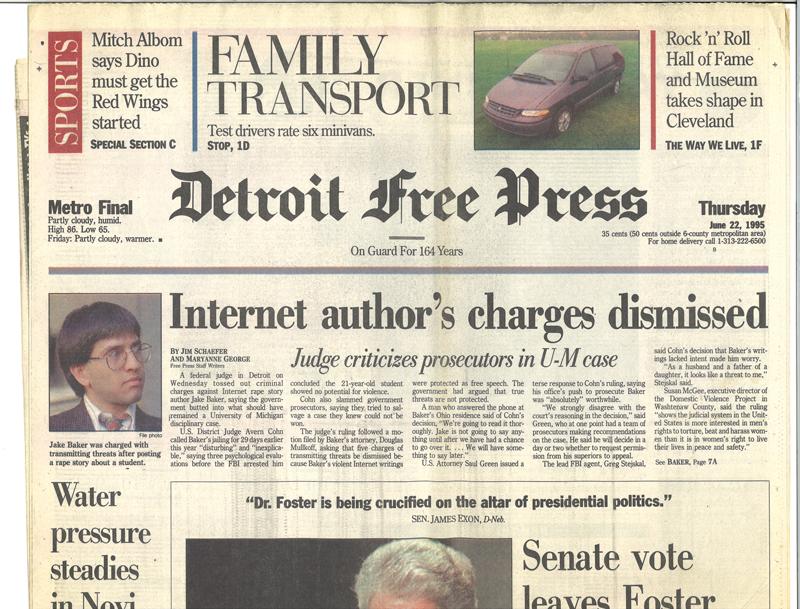United States v. Alkhabaz –
Free Speech – 1st Amendment – Emails
Brief Fact Summary. The Defendant, Abraham Jacob Alkhabaz, a.k.a. Jake Baker (Defendant), posted a story on a Usenet news group, “alt.sex.stories,” detailing the torture, rape, and murder of a young woman possessing the same name as one of the Defendant’s classmates at the University of Michigan.
Synopsis of Rule of Law. A “communication containing a threat” must be such that a reasonable person (1) would view the communication as expressing the intent to inflict bodily harm and (2) would view the communication as an attempt to effect change or achieve some goal through intimidation.
FACTS:
Defendant and another person exchanged e-mails, the content of which expressed a sexual interest in violence against women and girls. Defendant posted a fictional story on an interactive news group describing the torture, rape, and murder of a young woman who shared the name of one of defendant’s college classmates. Defendant was indicted on charges that he violated 18 U.S.C.S. § 875(c), which prohibited interstate communications containing threats to kidnap or injure another person. Defendant was subsequently indicted on a superseding indictment based on several e-mail messages between defendant and his e-mail friend. The district court dismissed the indictment, reasoning that the e-mail messages sent and received by defendant and his e-mail friend did not constitute “true threats” under the First Amendment, and, as such, were protected speech. The government appealed, arguing that the district court erred in dismissing the indictment because the communications constituted “true threats” and, as such, did not implicate First Amendment free speech protections.
ISSUE:
Did the e-mail messages constitute communications containing a threat under § 875(c), thereby not implicating First Amendment free speech protections?
Held.
No. Under federal law, it is illegal to transmit in interstate commerce a communication containing a threat to injure or kidnap another person. The government was able to easily prove that the story was transmitted in interstate commerce and the threat-if it were a threat-was to injure or kidnap another person. The difficulty is in defining a communication containing a threat. The Sixth Circuit Court of Appeals opined that a “communication containing a threat” must be such that a reasonable person (1) would view the communication as expressing the intent to inflict bodily harm, and (2) would view the communication as an attempt to effect change or achieve some goal through intimidation. Under this definition, the Defendant’s story did not constitute a threat, as it was not directed to the young woman whose name he used.
Dissent. A “threat” does not have to be directed at someone, but rather, the communication would lead a reasonable, objective recipient to believe that the writer was serious about the threat.
Discussion. A threat must lead a reasonable person to believe that the person making the threat seriously intends to carry it out and said threat serves some purpose, i.e. to effect change or achieve some goal.
CONCLUSION:
On appeal, the court affirmed the dismissal of the indictment. The court held that the e-mail messages did not constitute communications containing a threat under § 875(c), because no reasonable person would perceive such communications as being conveyed to effect some change or achieve some goal through intimidation. The court held that the e-mails were sent in an attempt to foster a friendship based on shared sexual fantasies.
cited https://www.lexisnexis.com/community/casebrief/p/casebrief-united-states-v-alkhabaz
cited https://www.casebriefs.com/blog/law/criminal-law/criminal-law-keyed-to-dressler/inchoate-offenses/united-states-v-alkhabaz/

